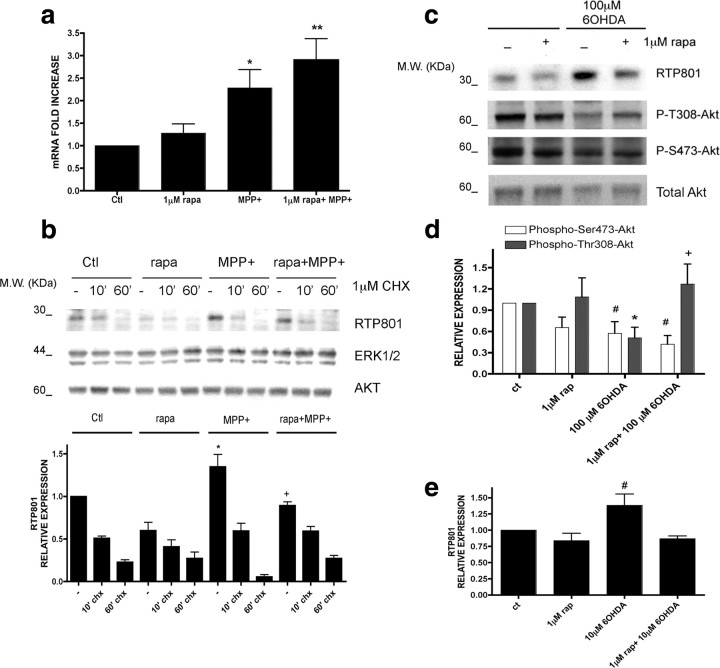Figure 4.
Effects of rapamycin on RTP801 mRNA, RTP801 turnover, and Akt phosphorylation. a, Neuronal PC12 cells were pretreated with 1 μm rapamycin and then exposed to 1 mm MPP+ for 8 h. RNA was extracted, and reverse transcription-PCR was performed to quantify the number of copies of cDNA coding for RTP801 under the indicated conditions. Values represent mean ± SEM of at least four independent experiments. *p < 0.05 versus control (Ctl); **p < 0.01 versus control (Ctl). b, Neuronal PC12 cells were pretreated with 1 μm rapamycin and then exposed to 1 mm MPP+ for 8 h. Then they were treated with or without 1 μm cycloheximide (CHX) for 10 or 60 min. Cell extracts were collected immediately after and subjected to SDS-PAGE and Western immunoblotting. Membranes were probed with the indicated immunoreagents and reprobed with antibodies for total ERK1 and Akt. Densitometry values represent mean ± SEM of at least three independent experiments. *p < 0.05 versus control (−) and + p < 0.05 versus MPP+ alone. M.W., Molecular weight. c, Neuronal PC12 cells were pretreated with or without 1 μm rapamycin and exposed to 100 μm 6-OHDA for 16 h. Cell extracts were analyzed by SDS-PAGE and Western immunoblotting. Membranes were probed with anti-phospho-Thr308–Akt, anti-phospho-Ser473–Akt, and anti-RTP801 antibodies. Membranes were reprobed with antibody against total Akt as loading control. Films were scanned and densitometries (NIH ImageJ) were expressed as arbitrary units versus total Akt loading control for the two phospho-Akt residues (d) and RTP801 (e). Values represent mean ± SEM of at least three independent experiments in each condition. # p < 0.05 versus phospho-Ser473–Akt in control extracts (Ct); *p < 0.05 versus phospho-Thr308–Akt in control extracts (Ct); + p < 0.05 versus phospho-Thr308–Akt in 100 μm 6-OHDA-treated cells.

